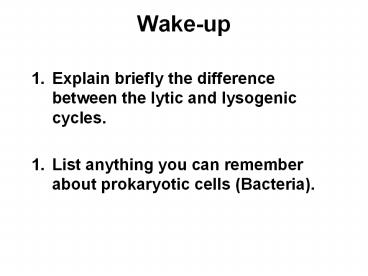Wake-up - PowerPoint PPT Presentation
1 / 38
Title: Wake-up
1
Wake-up
- Explain briefly the difference between the lytic
and lysogenic cycles. - List anything you can remember about prokaryotic
cells (Bacteria).
2
Bacteria
- Christopherson
3
Prokaryotic Cell Definition
Simple cells that lack membrane-bound
organelles. Membrane-bound means that they
have an outer layer.
4
Label the diagram of the Prokaryotic cell on your
notes
- Cytoplasm Cell Membrane
- Capsule Pili
- Flagella Cell Wall
- Ribosomes Plasmid
- DNA
5
Bacteria Structure
6
Bacterial Shapes
Bacillus Rod
7
Bacterial Shapes
Spirillum Spiral
8
Bacterial Shapes
Coccus Round
9
What Shape?
Bacillus
10
What Shape?
Coccus
11
Spirillum
12
Bacillus
Spirillum
Coccus
13
Feeding habits of Bacteria Autotroph
Producer an organism that makes glucose (food)
Photosynthesis
14
Where does photosynthesis take place in the
majority of producers?
Chloroplast
15
Where are the chloroplasts in Prokaryotic
cells????
Bacteria do not have chloroplasts. So.where
does photosynthesis take place?
16
Autotroph 1 Photosynthesis
Bacteria do NOT have chloroplasts, but have
chlorophyll which allows them to go through
photosynthesis
17
What is the summative equation for Photosynthesis?
Sunlight Energy
Carbon dioxide
Water
Glucose
Oxygen
Reactants What is needed
Products What is produced
18
Example Autotroph Cyanobacteria
Better known as Blue-Green Algae Fossils, more
than 3.5 billion years old, have been found of
cyanobacteria (The oldest known fossils)
19
One of the largest groups of bacteria The first
of organisms to group to produce oxygen into the
atmosphere
20
Autotroph 2 Chemosynthesis
Process in which Bacteria make glucose in the
absence of sunlight
They use CO2 and chemicals in their environment
to make glucose
21
Chemosynthesis takes place in the Deep Sea
Thermal vents at the bottom of the ocean. The
first one was discovered off the coast of the
Galapagos in 1977. It was about 1.5 miles/8000
feet deep
22
(No Transcript)
23
(No Transcript)
24
Plant Earth Video Clip (2415)
25
What is an Heterotroph?
Consumer an organism that cannot make glucose
(food) they need to consumer others
26
Heterotroph 1 Parasitic
- Bacteria feeds off of the host
- Bacteria benefits host is harmed
27
Example Streptococcus
- Streptococcus pneumoniae causes strep throat,
meningitis, and pneumonia - TransmissionDirect contact
28
(No Transcript)
29
Heterotroph Mutualistic
- Bacteria and the host benefit from each other
- If one were to die, the other would suffer or
eventually die
30
Example E. coli
- Escherichia coli (a.k.a. E. coli) lives in the
gut, where it helps digest food and produces
Vitamin K. - The "bad" strain of E. coli O157H7 causes severe
food borne sickness.
31
Heterotroph 3 Saprophytic
- AKA Decomposer
- Consumes dead organic matter
32
Example Micrococcus
33
Binary fission Asexual
34
Reproduction in unicellular organisms by division
into two daughter cells
What is Binary Fission?
35
How fast does this occur?
36
Conjugation Sexual Reproduction
37
The process by which genetic material is
transferred from one bacteria cell to another by
a sex pilus
What is Conjugation?
38































